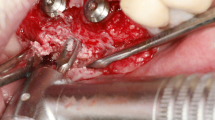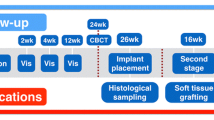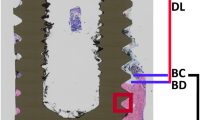Abstract
Objectives
This study seeks to assess and compare immunohistochemical characteristics of regenerated and pristine bone areas following surgical therapy of advanced peri-implantitis.
Methods
At ligature-induced peri-implantitis defects, the intrabony component was filled with a natural bone mineral (NBM), and the supracrestal component was treated by either an equine bone block (EB) or implantoplasty. NBM and EB were soak-loaded with rhBMP-2 or sterile saline. Membrane (i.e., native collagen) protected sites were submerged for 12 weeks. Osteocalcin (OC) and transglutaminase 2 (TG2; angiogenesis) antigen reactivity was assessed within the augmented- (AA) and pristine bone (PB) areas at non-exposed sites (n = 39 defects).
Results
In all groups investigated, mean OC (AA, 0.5 ± 0.4 to 1.9 ± 2.9 %/PB, 1.7 ± 2.6 to 3.5 ± 6.5 %) and TG2 (AA, 0.6 ± 0.5 to 1.3 ± 1.5 %/PB, 0.5 ± 0.5 to 1.6 ± 1.9 %) values within AA did not significantly differ from those values assessed within PB (P > 0.05, respectively).
Conclusions
AA formed in different treatment groups may not be considered as qualitatively (i.e., OC and TG2) compromised bone.




Similar content being viewed by others
References
Renvert S, Polyzois I, Maguire R (2009) Re-osseointegration on previously contaminated surfaces: a systematic review. Clin Oral Implants Res 20(Suppl 4):216–227
Lindhe J, Berglundh T, Ericsson I, Liljenberg B, Marinello C (1992) Experimental breakdown of peri-implant and periodontal tissues. A study in the beagle dog. Clin Oral Implants Res 3:9–16
Schwarz F, Becker J (2011) Animal models for peri-implant mucositis and peri-implantitis. Periodontol 2000 (in press)
Claffey N, Clarke E, Polyzois I, Renvert S (2008) Surgical treatment of peri-implantitis. J Clin Periodontol 35:316–332
Schwarz F, Sahm N, Iglhaut G, Becker J (2011) Impact of the method of surface debridement and decontamination on the clinical outcome following combined surgical therapy of peri-implantitis: a randomized controlled clinical study. J Clin Periodontol 38:276–284
Schwarz F, Sahm N, Mihatovic I, Golubovic V, Becker J (2011) Surgical therapy of advanced ligature-induced peri-implantitis defects: cone-beam computed tomographic and histological analysis. Ther Peri-implantitis J Clin Periodontol 38:939–949
Mair B, Fuerst G, Kubitzky P, Tangl S, Bergmeister H, Losert U, Watzek G, Gruber R (2007) The anti-angiogenic substance TNP-470 impairs peri-implant bone formation: a pilot study in the rabbit metaphysis model. Clin Oral Implants Res 18:370–375
Schwarz F, Rothamel D, Herten M, Ferrari D, Sager M, Becker J (2008) Lateral ridge augmentation using particulated or block bone substitutes biocoated with rhGDF-5 and rhBMP-2: an immunohistochemical study in dogs. Clin Oral Implants Res 19:642–652
Schwarz F, Ferrari D, Sager M, Herten M, Hartig B, Becker J (2009) Guided bone regeneration using rhGDF-5- and rhBMP-2-coated natural bone mineral in rat calvarial defects. Clin Oral Implants Res 20:1219–1230
Donath K (1985) The diagnostic value of the new method for the study of undecalcified bones and teeth with attached soft tissue (Sage-Schliff (sawing and grinding) technique). Pathol Res Pract 179:631–633
Hanisch O, Tatakis DN, Boskovic MM, Rohrer MD, Wikesjo UM (1997) Bone formation and reosseointegration in peri-implantitis defects following surgical implantation of rhBMP-2. Int J Oral Maxillofac Implants 12:604–610
Owen TA, Aronow M, Shalhoub V, Barone LM, Wilming L, Tassinari MS, Kennedy MB, Pockwinse S, Lian JB, Stein GS (1990) Progressive development of the rat osteoblast phenotype in vitro: reciprocal relationships in expression of genes associated with osteoblast proliferation and differentiation during formation of the bone extracellular matrix. J Cell Physiol 143:420–430
Hauge EM, Qvesel D, Eriksen EF, Mosekilde L, Melsen F (2001) Cancellous bone remodeling occurs in specialized compartments lined by cells expressing osteoblastic markers. J Bone Miner Res 16:1575–1582
Haroon ZA, Hettasch JM, Lai TS, Dewhirst MW, Greenberg CS (1999) Tissue transglutaminase is expressed, active, and directly involved in rat dermal wound healing and angiogenesis. Faseb J 13:1787–1795
Jones RA, Kotsakis P, Johnson TS, Chau DY, Ali S, Melino G, Griffin M (2006) Matrix changes induced by transglutaminase 2 lead to inhibition of angiogenesis and tumor growth. Cell Death Differ 13:1442–1453
Gallop PM, Lian JB, Hauschka PV (1980) Carboxylated calcium-binding proteins and vitamin K. N Engl J Med 302:1460–1466
Boivin G, Morel G, Lian JB, Anthoine-Terrier C, Dubois PM, Meunier PJ (1990) Localization of endogenous osteocalcin in neonatal rat bone and its absence in articular cartilage: effect of warfarin treatment. Virchows Arch A Pathol Anat Histopathol 417:505–512
Hauschka PV, Lian JB, Cole DE, Gundberg CM (1989) Osteocalcin and matrix Gla protein: vitamin K-dependent proteins in bone. Physiol Rev 69:990–1047
Schwarz F, Herten M, Sager M, Wieland M, Dard M, Becker J (2007) Histological and immunohistochemical analysis of initial and early osseous integration at chemically modified and conventional SLA titanium implants: preliminary results of a pilot study in dogs. Clin Oral Implants Res 18:481–488
Acknowledgments
We kindly appreciate the skills and commitment of Mrs Hartig, Mr Kaiser, and Mr Lommen (Department of Oral Surgery, Heinrich Heine University, Düsseldorf, Germany) in the preparation of the histological specimens.
Source of funding
The study was funded by the Osteology Foundation, Lucerne, Switzerland and the Camlog Foundation, Basel, Switzerland. The study materials and devices were kindly provided by Camlog Biotechnologies AG, Basel, Switzerland. Geistlich Biomaterials, Wolhusen, Switzerland.
Conflict of interest statement
The authors declare that they have no conflict of interests related to this study.
Author information
Authors and Affiliations
Corresponding author
Additional information
Frank Schwarz and Ilja Mihatovic equally contributed to the study and are considered as joint first authors.
Rights and permissions
About this article
Cite this article
Schwarz, F., Mihatovic, I., Golubovic, V. et al. Immunohistochemical characteristics of regenerated bone after surgical therapy of advanced ligature-induced peri-implantitis defects. Clin Oral Invest 18, 1679–1686 (2014). https://doi.org/10.1007/s00784-013-1138-5
Received:
Accepted:
Published:
Issue Date:
DOI: https://doi.org/10.1007/s00784-013-1138-5




